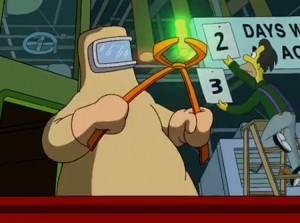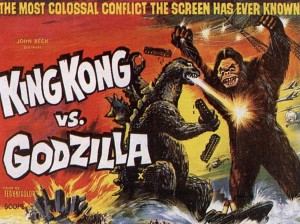
Image: The Simpson (Fox)
Yesterday, I let grappling with trolls distract me from blogging actual interesting things. This is no one’s fault but my own, but I’m going to whine about it anyway.
Before I went to bed last night, I scribbled a note to myself to write more about the Fukushima disaster, particularly the peculiar relationship with nuclear energy that’s on display in American pop culture.
It bothers me that, in arguing with the opportunists and the xenophobes yesterday, I may have appeared to be dismissing nuclear dangers when my intent was to dismiss the trolls. I’ll start with the explicitly serious stuff and then move on to a few interesting examples of atomic imagery in entertainment (or, in Disney’s case, the precurser to infotainment).
Today, the Washington Post featured this article, For Tepco and Japan’s Fukushima Daiichi nuclear plant, toxic water stymies cleanup.
That seems like a good place to start this post.
Two and a half years after a series of nuclear meltdowns, Japan’s effort to clean up what remains of the Fukushima Daiichi power plant is turning into another kind of disaster.
The site now stores 90 million gallons of radioactive water, more than enough to fill Yankee Stadium to the brim. An additional 400 tons of toxic water is flowing daily into the Pacific Ocean, and almost every week, the plant operator acknowledges a new leak.
That operator, Tokyo Electric Power Co., known as Tepco, was put in charge of the cleanup process more than two years ago and subsequently given a government bailout as its debts soared. The job of dismantling the facility was supposed to give Tepco an opportunity to rebuild credibility.
But many lawmakers and nuclear industry specialists say that Tepco is perpetuating the kinds of mistakes that led to the March 2011 meltdowns: underestimating the plant’s vulnerabilities, ignoring warnings from outsiders and neglecting to draw up plans for things that might go wrong. Those failures, they say, have led to the massive buildup and leakage of toxic water.
“Tepco didn’t play enough of these what-if games,” said Dale Klein, a former chairman of the U.S. Nuclear Regulatory Commission, who recently joined a Tepco advisory panel. “They didn’t have enough of that questioning attitude” about their plans.
The article is a long read that’s well-worth your time, whether you think you’re interested or not.
Because you should be interested.
And now, because I believe the word “should” is weak and should be mercilessly edited out of any piece you wish taken seriously, I can’t stop pompously writing “should” statements. The more I try to change my language in this post the worse it gets, so maybe I should just…oh, nevermind.
Let’s just forge ahead. If I put this into the drafts folder until later I’ll never get it published, so here it is, chock full of sanctimonious should statements I can’t seem to stop myself from using…
You should be interested in the Fukushima meltdown and it’s aftermath because other human beings on this planet are suffering, because of the damage to the environment, and because of the important lessons to be learned from the accident, the response, and the consequences.
You shouldn’t be interested because there could be a way to make a buck selling dubious products or medical treatments to vulnerable people – in Japan or anywhere else.
You should be deeply concerned about the health consequences of this disaster for people – especially Japanese children – who are actually being impacted by this disaster. Because they’re human beings. If you missed the fracas over my previous post – hysterical fears about the possiblity of “mutant” children in Japan or the U.S. took an even uglier turn than I wish to rehash here. I will reiterate that any human being who is harmed by any environmental accident is still a human being, not a damaged creatures who should be warehoused so you don’t have to see them or be reminded that human folly has consequences.
On a little bit of a tangent, I just learned that in 2011 in the wake of the Fukushima disaster, Germany, Austria and Switzerland banned episodes of the Simpsons that make jokes about nuclear disasters.
According to this brief Entertainment Weekly interview with Simpson’s Executive Producer Al Jean, the studio has willingly provided stations with a detailed list of episodes that contain story elements about nuclear accidents or radiation.
Interesting.
I’m not going to link to any of the idiotic posts I just read accusing European media of censorship for not airing reruns of a show making light of nuclear accidents. They’re poorly argued and take this post too far afield – particularly in light of the fact that it didn’t actually become illegal to view or possess the episodes, the stations just aren’t going to air those reruns again any time soon.
I’ve been thinking a lot about the ways that The Simpsons normalizes our relationship with human error and nuclear power. Although the show is satirical, and it’s obvious no one is meant to view Homer Simpson as a role model, I wonder what effects 20 years of jokes about nuclear disaster and nuclear waste have on our attitudes toward nuclear accidents?
Does it make us less concerned about our immediate environment? Less sympathetic to people in other places who experience the consequences of uncontrolled radiation? Does it make the default attitude, “Well, if they didn’t want a disaster, they should have hired better workers?”
I don’t mean to suggest that The Simpsons are to blame for warping our understanding of atomic energy, particularly regarding the idea that atomic or nuclear production is less an industrial process and more of a natural process.
For that we can blame Walt Disney.
The blog Brain Pickings posted some of the most interesting illustrations from the book, Our Friend the Atom, but I recommend you watch the original movie, as broadcast on television in 1957.
Our Friend the Atom:
If you don’t have an hour to spend with the Wonderful World of Disney, you can easily find the program posted in 10 minute segments that are labelled by chapter. I’m not going to link them all here because I have faith in your youtube skills.
And also because I’m a little bit lazy, but that’s not news.
{Comments are closed on this site at this time, but you’re welcome to leave a comment on facebook or contact me on twitter: @meanlouise}

